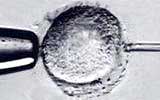Talk:BGD Tutorial - Applied Embryology and Teratology: Difference between revisions
No edit summary |
|||
| Line 51: | Line 51: | ||
===ART 2007=== | ===ART 2007=== | ||
[[Image:In_vitro_fertilzation.jpg|thumb|IVF]] [[Image:ART types USA 1996.png|thumb|ART types USA 1996]] | |||
===Single Embryo Transfers (SET)=== | ===Single Embryo Transfers (SET)=== | ||
Revision as of 15:33, 17 January 2012
Page History
- 2012 - Update Australia’s mothers and babies 2009
Mothers
- 2007 289,496 women gave birth to 294,205 babies
- 2008 292,156 women gave birth to 296,925 babies
- 2007 increase of 4.3% from 2006, and 14.4% increase since 2004
- fetal death component was 2,177 and 2,188 respectively
- 29.9 years was the maternal mean age in 2007
- compared with 28.9 years in 1998 Why is this increasing age important?
- the rate of women aged 15–44 years giving birth in the population decreased slightly between 2007 and 2008.
- 41.6% of mothers had their first baby and 33.5% had their second baby
- 10,883 women were Aboriginal or Torres Strait Islander (3.8% of all women who gave birth)
- 39.5% of all mothers in the Northern Territory
- 25.2 years was the average age of these women who gave birth
- 3.1% women received ART treatment (see also below Assisted Reproduction Technology)
- 2011 - Update Birth defects in Victoria 2005 to 2006
http://www.health.vic.gov.au/ccopmm/vpdc/index.htm
http://www.health.vic.gov.au/ccopmm/downloads/birth_report.pdf
Top birth defects in Victoria - With a few exceptions, the majority of birth defects most commonly found in Victoria are not severe or life threatening to the child.
The incidence of the most common conditions in Victoria in 2005–2006 (in order of prevalence) was found to be:
- Hypospadias – the urethral opening is located on the underside of the penis: one in 135 (male) births
- Obstructive defects of the renal pelvis – abnormalities of the urinary tract: one in 250 births
- Ventricular septal defect – a hole in the tissue that divides the two heart chambers: one in 311 births
- Trisomy 21 – also known as Down’s syndrome, caused by an additional 21st chromosome: one in 339 births
- Congenital dislocation of the hip – the ball of the thigh bone doesn’t fit snugly into the hip bone socket: one in 364 births
- Trisomy 18 – also known as Edward syndrome, includes multiple abnormalities (including those of the heart, diaphragm, lung, kidneys, ureters and palate) caused by an additional 18th chromosome: one in 1,190 births
- Hydrocephalus – a build-up of cerebrospinal fluid inside the skull: one in 1,235 births
- Cleft palate – the roof of the mouth is split down the middle: one in 1,250 births
- Renal agenesis and dysgenesis – one or both kidneys are missing (agenesis) or the kidney is malformed (dysgenesis): one in 1,515 births
- Transposition of the great vessels – the two main arteries leaving the heart are reversed which changes the way blood circulates through the body, leaving a shortage of oxygen in blood flowing from the heart to the rest of the body: one in 1,587 births.
- Neural tube defects
Neural tube defects, such as anencephaly and spina bifida, occur just outside the top 10 most common birth defects, but are widely known. Their prevalence has generally decreased since 1993, most likely due to an increased awareness by the public of their prevention and increased use of folic acid:
- Spina bifida – malformations of the spinal column: one in 1,667 births
- Anencephaly – the brain is partially or completely absent: one in 1,818 births.
- 2010 - Original page on website 2010_BGD_Tutorial_-_Applied_Embryology_and_Teratology. Replaced as now removing dates from pages to avoid multiple copies and confusing navigation. With Wiki, can always view history to see earlier versions.
- 2009 and 2008 - On original website http://embryology.med.unsw.edu.au/Medicine/BGD2tutorial.htm linked to other content pages.
ART 2007
Single Embryo Transfers (SET)
- Significant increase in the number of SET embryos transfer cycles (2002 28.4%, 2005 48.3%)
- increase of SET cycles resulted more singleton deliveries (singleton deliveries 2005 was 85.9%)
- single-embryo transfer babies had better outcomes compared to babies born to women who had a double-embryo transfer (DET).
- 2005 3,681 SET babies and 5,589 DET babies.
- Singletons babies - 96.1% SET, 61.6% DET
- Preterm babies - 11.7% SET, 30.6% DET
- Low birthweight liveborn babies - 8.0% SET, 25.0% DET
ART Perinatal mortality rate
- perinatal mortality rate was 14.7 deaths per 1,000 births (2005)
- 23.8% decrease from 19.3 deaths per 1,000 births in 2004
- Perinatal mortality rate was the lowest among singletons born following SET (7.3 deaths per 1,000 births) in 2005.
(Reference: AIHW National Perinatal Statistics Unit Assisted Reproduction Technology in Australia and New Zealand 2005)
Tutorial Handout
- Current handout print version of Wiki page.
- Previous handouts included teratogenesis extract from "Embryology made Easy" M.W Rana http://www.amazon.com/Human-Embryology-Made-Easy-Waheed/dp/9057025450
- Spiral-bound: 376 pages
- Publisher: CRC Press (July 28, 1998)
- Language: English
- ISBN-10: 9057025450
- ISBN-13: 978-9057025457
eMed
Activity URL Link
http://emed.med.unsw.edu.au/Map.nsf/0/A68811EF91CD53B0CA257339000629DC?OpenDocument&login

